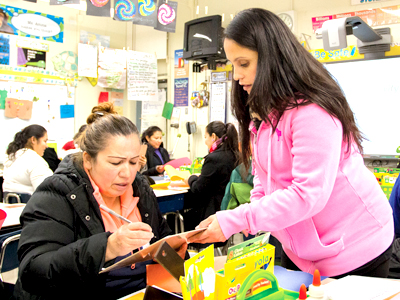
Parent involvement in their children's school is associated with a range of positive outcomes for students, says a new EdSource report.
California’s new legislation reforming how the state funds its public schools (Assembly Bill 97) puts more power in the hands of school districts and gives parents and communities a stronger voice—and greater responsibility—in dictating how those dollars are actually spent.
Under the Local Control Funding Formula, additional funds will be directed to districts and student populations based on the number of low-income students, English learners and foster children they serve, in the expectation that the extra funds will be used to improve the educational outcomes of these high- needs students.
The Accountability Plan requires specific plans to increase parent involvement. School districts will be expected to involve parents in a timely manner so that they can effectively contribute to the development of the plan. Districts will also have to show what changes were made to the plan in response to input from parents and other stakeholder—and to show how that input contributed to improved outcomes for students.
The most widely adopted framework for viewing different levels of parent involvement comes from Johns Hopkins University’s Joyce Epstein, who has identified six ways for schools to involve parents:
1. Help with parenting. Schools assist families with parenting skills and provide family support.
2. Communications. Schools communicate with families about programs, curricula and student progress, and create two-way communication channels between school and home.
3. Volunteering. Schools actively recruit parents as volunteers in a wide range of activities.
4. Learning at home. Schools help involve parents in their child’s learning at home, including doing homework, helping their children set goals and other activities related to the school curriculum.
5. Decision-making. Schools include families as participants in school decisions, governance and advocacy activities through school councils or improvement teams, committees and parent organizations.
6. Collaboration. Schools help coordinate their own resources and services for families, students and the school with community organizations, businesses and cultural organizations.
What the research shows
The results of a new research by EdSource, in collaboration with New America Media, show that:
- Parent involvement at home and at school has a measurable impact on student performance in school, and is particularly important for English learners and students from low-income families.
- Improved communication between teachers and parents increases student engagement as measured by homework completion rates, on-task behavior and class participation.
- Behaviors such as alcohol use, violence and other anti-social behaviors decrease as parent involvement increases.
In Alameda County, schools have begun several activities to improve parental involvement.
“Schools are surveying parents and are doing a number of trainings for parents,” says Sheila Jordan, Alameda County Superintendent of Schools.
Jordan adds that the schools are looking to host parents more often at school to allow parents and students to work together in the classroom. The school districts also want to see greater involvement from fathers, though they are often working two to three jobs.
“Most of the time it is only the women who are involved with the schools,” says Jordan. “We want to include men.”
She concludes by saying that the goal is for schools to have a good relationship with the parents.
“The Latino community is very warm and open - the key to communications is to listen, trust and respect.”
